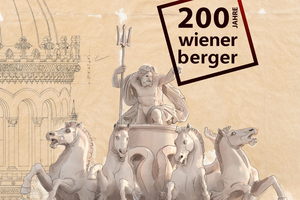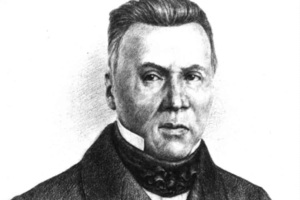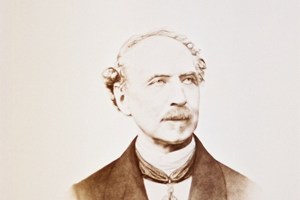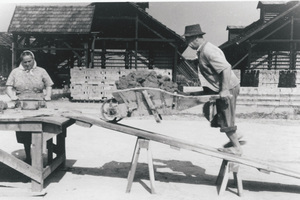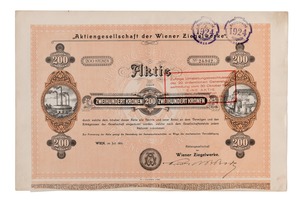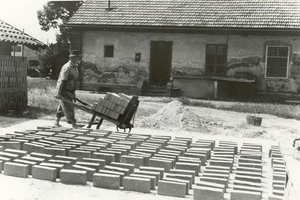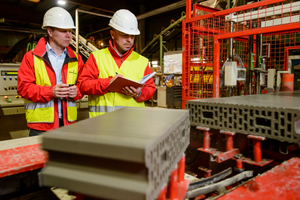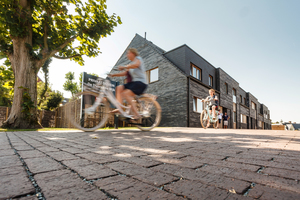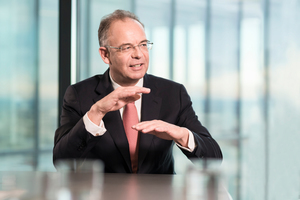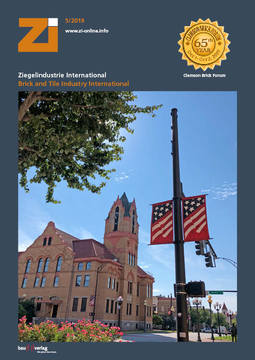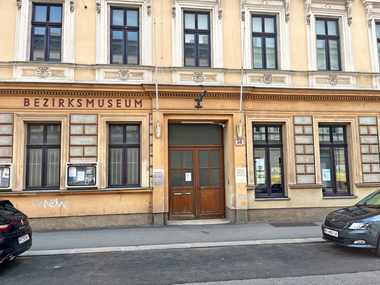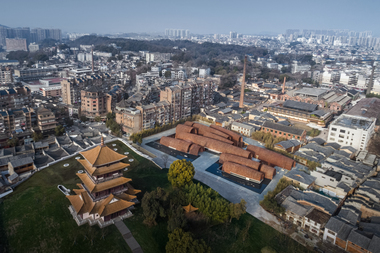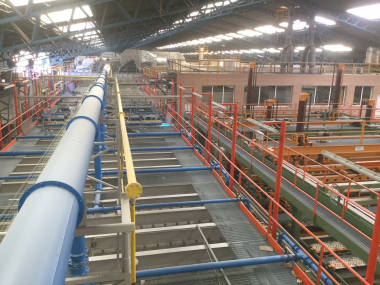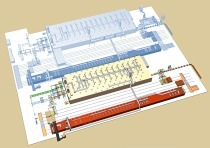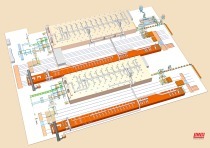200 years of Wienerberger – from brickworks to system supplier
In 2019, Wienerberger is celebrating its 200th anniversary. Over the years, the company has developed from a brickworks in Vienna to a globally operating manufacturer of construction materials offering innovative solutions for the building envelope and a smart infrastructure.
It all depends on the location! The history of Wienerberger shows that this is crucial.
The rich deposits of clay on the southern edge of the city are crucial for the main location in Vienna, Austria, where Wienerberger is still headquartered today. In the early 19th century, Vienna is already a city with buoyant building activity. The civil engineer Alois Miesbach sees this, and in 1819 he takes over a state-owned brickworks in Vienna-Meidling. Two years later, he leases sites and other brick kilns in the Wienerberg district and lays the foundation for the globally operating corporation that is Wienerberger AG today.
Growth of the brickworks
Within one generation, the visionary entrepreneur, Alois Miesbach, succeeded in turning a local family business into one of the biggest brickworks in Europe, which is producing 50 mill. clay bricks per year by 1845. The production site in Wienerberg, a suburb to the south of Vienna, comprises 37 kilns, around 200 drying yards in the open and more than 100 drying sheds for clay blocks and roofing tiles.
Miesbach profits from the enormous demand for bricks in the fast-growing city of Vienna. In 1855, the total production volume amounts to over 126 million bricks. However, Alois Miesbach does not just buy brickworks, but has an entrepreneurial vision. He buys coal mines and property and optimizes his logistics to ensure the transport of coal, clay and finished products between his production sites and Vienna as the biggest sales market.
In 1857, Heinrich Drasche takes over his uncle’s business. He is one of the most influential and prosperous business magnates in the Austro-Hungarian Monarchy. Drasche, too, invests in property. The construction of the Vienna ring road as a new grand boulevard triggered a boom in building. In 1860, Heinrich Drasche introduces a key innovation; the Hoffmann continuous kiln. Drasche recognizes its potential benefits early on and acquires the patent two years later. In 1864, Heinrich Drasche begins retrofitting all his factories with these efficient kilns. On account of this successful industrial development, Drasche turns the brick enterprise into a stock corporation. In 1869, exactly 150 years ago, Wienerberger is listed for the first time on the Vienna Stock Exchange.
Economic recovery after the Second World War
By the end of the Second World War, most of the production facilities south of Vienna has been destroyed.
From 1947, the slow process of reconstruction begins. The post-war years are marked by automation, a record level of investments and record production volumes for the reconstruction of Vienna. Besides the production of perforated bricks, the pioneering work of Wienerberger in the 1950s leads to the installation of state-of-the-art tunnel kilns. In the following years, Wienerberger produces bricks in larger sizes to speed up construction work and to set new standards in thermal insulation.
Comprehensive solutions – from bricks through mortar to masonry – facilitates planning and raises the quality of construction work to a new level. The introduction of precision-ground bricks constitutes yet another milestone which makes brickwork easier and more cost-efficient.
Development to global player
The end of the 1980s, with internationalization marks the beginning of a new chapter in the history of Wienerberger.
Following the takeover of the German Oltmanns Group, the company expands into Central Eastern Europe, Southern and Western Europe in the 1990s. This exciting period in the company’s history sees the establishment of the Pipelife joint venture for the plastic pipe business, the expansion of the ceramic pipe business, the development of the facing brick business and the entry into the concrete pavers market.
With the acquisition of General Shale, a leading brick producer in the USA, Wienerberger takes the first step towards becoming a global player in 1999. A few years later, the company enters the Canadian market.
Another strategic milestone is the Group‘s entry into the roofing sector through the acquisition of Koramic in 2003; this line of business was steadily expanded in the following years.
At the beginning of the 2000s, Wienerberger moves on to become a world market leader in bricks and the second largest manufacturer of clay roofing tiles.
A changing market environment
During the global economic crisis, Wienerberger sets out on a new course of action in 2009.
Comprehensive restructuring within the company provides the basis for its successful adaptation to a new market environment. The company’s focus is on organic growth. Customer proximity, efficient processes and innovative products, such as insulation-filled clay blocks with excellent thermal insulation properties or the Dryfix adhesive system for brick walls, are key growth drivers.
In 2012, Wienerberger takes over Pipelife, the plastic pipe specialist; two years later, it acquires the remaining shares in the roofing tile manufacturer Tondach Gleinstätten.
Wienerberger’s major objectives are to strengthen its presence in fast-growing markets. In 2018, the company takes advantage of a number of opportunities and acquires the Dutch brick producer Daas Baksteen, the Norwegian pipe specialist Isoterm and the Romanian paver plant Nadab.
Wienerberger focuses on companies with high-margin products that can be quickly integrated into the existing portfolio. At the same time, Wienerberger is exiting non-strategic and non-profitable business areas. A first important step toward portfolio optimization is the sale of Semmelrock Austria. In this area, Wienerberger is now concentrating fully on highly profitable business in the Eastern European growth markets, which is performing very well.
Wienerberger is focusing on increasing profitability and improving organizational efficiency, the goal being to become less dependent on economic trends.
Recently, Wienerberger has entered into joint ventures with start-ups like Interbran and Fastbrick Robotics – these enable Wienerberger to broaden its product portfolio.
The Wienerberger strategy 2020
Today, Wienerberger’s vision is to be the most highly regarded producer of building materials and infrastructure solutions and the employer of choice in its markets. The Wienerberger Strategy 2020 ensures that these goals can be achieved.
Wienerberger sees itself as a market leader in smart solutions and a pioneer of digitalization in the industry. New technologies, such as concept visualization apps, make it easier for customers to make the right decisions. Web shops for distributors as well as digital planning and tendering software are revolutionizing building design. Wienerberger is promoting initiatives for Industry 4.0.
The company’s focus is on organic growth, operational excellence and a strong portfolio.
What began in 1819 with the acquisition of a brickworks in the Wienerberg district has evolved two hundred years later into a global group of companies with 195 production sites across the group in 30 countries. Wienerberger is regarded as the biggest brick producer worldwide, as the No. 1 in clay roofing tiles in Europe and as a market leader in concrete pavers in Central and Eastern Europe and in pipe systems in Europe.
In the first six months in 2019, the company reported new record figures for sales and revenue. Wienerberger already generates a third of its total sales with innovative solutions and services. These range from prefabricated wall elements according to digital construction plans through individual electrical engineering solutions in building services engineering to novel materials and smart solutions to meet the challenges of climate change.
In 2020, the company will move into a newbuild facility, the façade of which spectacularly sets the scene with clay bricks and is also convincing with regard to energy efficiency.
In terms of equal rights and opportunities, Wienerberger is truly a model: Since June 2019, with Solveig Mennard-Galli as Chief Performance Officer, a woman has sat alongside CFO Willy Van Riet and CEO Heimo Scheuch on the Wienerberger Board.
Wienerberger AG
www.wienerberger.com
Brick Award: Brick architecture has tradition
Cooperation with well-known architects has a long tradition at Wienerberger. The triumphal arch of Wienerberger Ziegelfabriks- und Baugesellschaft, which was designed by Heinrich Ferstel in the 19th century, attracted wide attention at Vienna’s World Exhibition in 1873. Theophil Hansen, renowned as one of the leading architects of the Viennese ring road, used metre bricks supplied by Wienerberger for the first time for the parliament building in Vienna.
Since 2004, Wienerberger has presented the Brick Award every two years in recognition of outstanding brick architecture, impressively upholding this tradition. In 2018, almost 600 projects were submitted from 50 countries.

